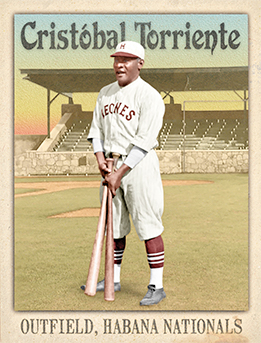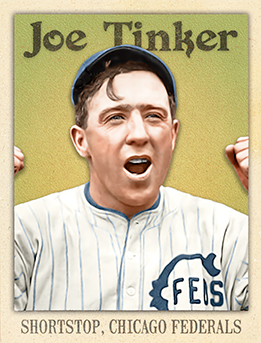
- Series: Diamond Heads '15
- City: New York
- Team: Giants
- League: National League
James Francis Thorpe (1888-1953) grew up in the Sac and Fox nation in Oklahoma, a hardscrabble existence that saw him in and out of boarding schools. Orphaned and troubled, the teenager found himself in faraway Pennsylvania and came under the tutelage of the renowned Pop Warner. Thorpe’s athletic skill would carry him to heights few have attained, a Renaissance man of sport, bestride the 20th Century. Acclaimed as the world’s greatest athlete in the 1912 Olympics where Thorpe played in two exhibition baseball games, presaging a professional career. A rare “free agent” in the era of the reserve clause, he was able to choose the Giants over the last-place Browns during the 1913 season. He played sporadically but went to the World Series and was the star of the global tour of Giants/White Sox players that off-season.
- Team owners caromed Thorpe from team to team with limited playing time, ending his MLB tenure with the Boston Braves in 1919
- Hit the ball that Hippo Vaughn misplayed, ending the remarkable “double-no-hitter” in 1917
- Series: Diamond Heads '15
- City: Chicago
- Team: Chi-Feds
- League: Federal League
- Hall: National Baseball Hall of Fame
Joseph Bert Tinker (1880-1948) sparkled at short, helping the Cubs to 4 pennants and 2 Series wins. He and fellow rookie Johnny Evers turned their first double-play to Frank Chance on Sep 13, 1902. A fight over a cab ride left Tinker and Evers estranged for years, but didn’t prevent them from playing 2nd “like one man, not two.” Tinker was widely held to be second only to Honus Wagner at SS, leading the league in many fielding categories. As skilled as he was afield, Tinker was also one of the great clutch hitters. Christy Mathewson deemed him the NL player he least wanted to see.
- On June 28, 1910 Tinker became one of a handful to steal home twice in a game
- Asked to leave the Cubs when Evers was made manager in 1913 but filled that role himself after a hiatus with the Federal League
- Elected to Hall of Fame: 1946

- Series: Diamond Heads '15
- City: Havana
- Team: Leones
- League: Cuban National League
- Hall: Cuban Baseball Hall of Fame, National Baseball Hall of Fame
Cristobal Torriente (1893-1938) had the Babe Ruth build (stocky with spindly, slightly bowed legs) and, more than that, he had a Ruthian swat. He punched his ticket to the Hall of Fame by starring in Cuba and America’s Negro Leagues. In 1920 he was dubbed the “Black Babe Ruth” during an off-season exhibition against Torriente’s Almendares club versus the New York Giants who brought the Babe along. Per his Cooperstown plaque, Cristobal outhit and out-homered the Sultan of Swat over the nine game series, earning a nickname for the ages. Like the best Cuban players, Torriente had been playing at home and in the States for black franchises since 1913. He soon caught the attention of J. L. Wilkinson who signed him for the “All Nations” squad for several years. He helped lead the Chicago American Giants to the first three pennants in the Negro League. The left-handed batter (the Ruth parallels just kept coming) not only hit for power but was often around .400. Fleet of foot (sorry Babe) Torriente was a marvel in the outfield despite his physique and he had a great arm. A rival manager, C.I. Taylor, once remarked “If I see Torriente walking up the other side of the street, I would say, ‘There walks a ballclub.’” He averaged .344 over a long career in black baseball and set the Cuban Winter Leagues record at .350 overall.
- Sadly there was another way in which Torriente patterned himself after Ruth. He loved the nightlife and frequently over-indulged which led to fights with umpires and management. His alcoholism took a dire toll, plunging the slugger into poverty where he fell victim to tuberculosis and an all-too-early death at 44
- The Cuban Hall of Fame was inaugurated a few weeks after Cooperstown’s. Torriente was among the initial class of ten in 1939
- Elected to Hall of Fame: 2006


